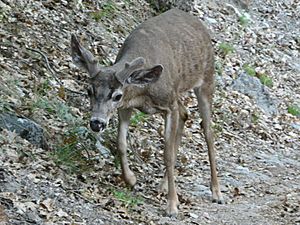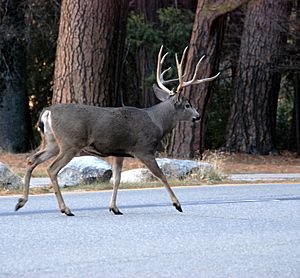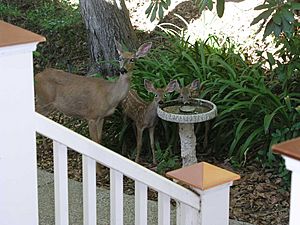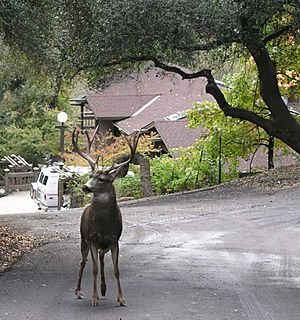California mule deer facts for kids
Quick facts for kids California mule deer |
|
|---|---|
 |
|
| A young buck in Yosemite National Park | |
| Scientific classification |
|
| Kingdom: | Animalia |
| Phylum: | Chordata |
| Class: | Mammalia |
| Order: | Artiodactyla |
| Family: | Cervidae |
| Subfamily: | Capreolinae |
| Genus: | Odocoileus |
| Species: | |
| Subspecies: |
O. h. californicus
|
| Trinomial name | |
| Odocoileus hemionus californicus (Caton, 1876)
|
|

The California mule deer (Odocoileus hemionus californicus) is a type of mule deer found in many parts of California. These deer are known for their unique antlers and how they live in the wild.
Contents
What Makes Them Special?
One way to tell the California mule deer apart from other deer, like the black-tailed deer and white-tailed deer, is by their antlers. A male deer's antlers grow in a special way. For the California mule deer, their antlers usually fork, or split, and grow upwards. Other types of deer might have antlers that grow more forward.
Where Do They Live?
You can find the California mule deer, O. h. californicus, all over northern and central California. They live in places like the California coastal prairie and the inner coastal mountains. They are also common in the Sierra Nevada mountains. These deer don't usually live on the flat valley floors. If you see them there, it's often near rivers or streams.
Their Home and Food
California mule deer like to live in hilly areas. They especially enjoy oak woodlands. These deer are mostly browsers, which means they eat leaves and twigs. Over 90% of their diet comes from shrubs and leaves. The rest of their food comes from grasses.
What Do They Eat and Do?
California mule deer usually eat close to lakes or streams. This is where they get their water. They might travel about 1 to 2 miles from a water source to find food. They often rest in grassy spots under trees, usually within a mile of both water and food.
When they rest often in the same spot, they might create a nearly flat area about 2 meters wide. Less used resting spots just look like flattened grass. On hot summer days, these deer often look for shade and rest during the middle of the day.
In summer, California mule deer mainly eat leaves from small trees, shrubs, and other plants. They also enjoy many kinds of berries, like blackberry, huckleberry, and thimbleberry. In winter, they might eat conifers (like Douglas fir twigs), aspen, willow, dogwood, juniper, and sage. They eat acorns all year round. Grasses are a less important food source for them. If people build homes or farms near deer habitats, the deer might also eat garden plants, fruit from trees, and sometimes even pet food.
Young deer (fawns) and their mothers (does) usually eat together in family groups. Male deer (bucks) often travel alone or with other bucks. California mule deer are most active when eating around sunrise and sunset. They might also look for food at night in open farm areas or when they feel unsafe.

How They Have Babies
The breeding season, called rutting season, happens in autumn. This is when the does are ready to have babies. This period only lasts for a few days. Male deer act aggressively to compete for mates. If a doe doesn't get pregnant, she will be ready to have babies again later.
The babies grow inside the mother for about 200 days. The fawns are born in the spring. They stay with their mothers all summer and stop drinking milk in the autumn. The male deer's antlers fall off in the winter. They start growing new ones in the spring, ready for the next autumn's breeding season.
Deer and People
For a very long time, the Native American people of California hunted California mule deer. This means that for thousands of years, people helped control the number of deer.
In more recent times, since European settlers came to California, more people started hunting. Hunting became more than just a way to get food. Also, as more people moved to California and built cities and towns, a lot of the deer's natural home was taken away. This has been happening since the late 1800s and continues today.
Images for kids



